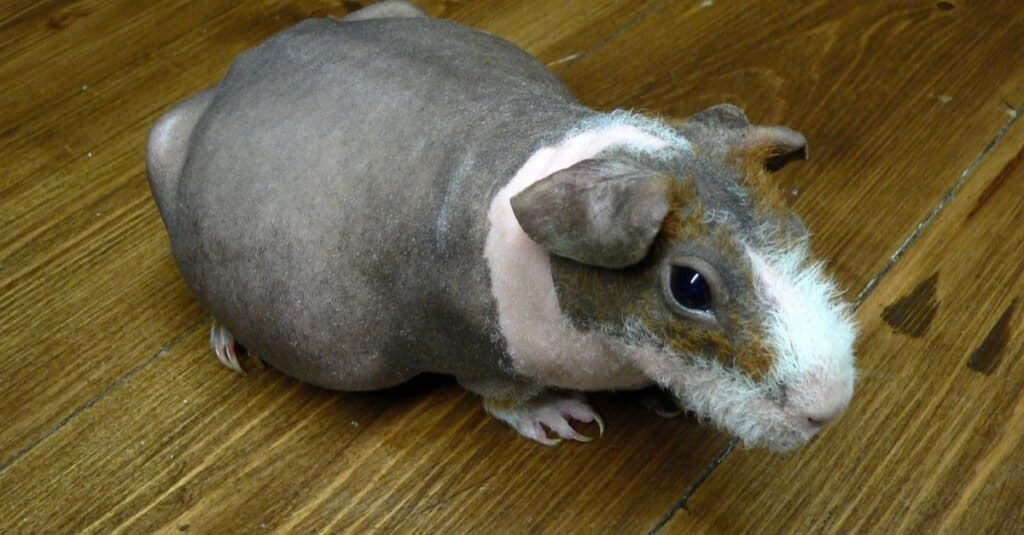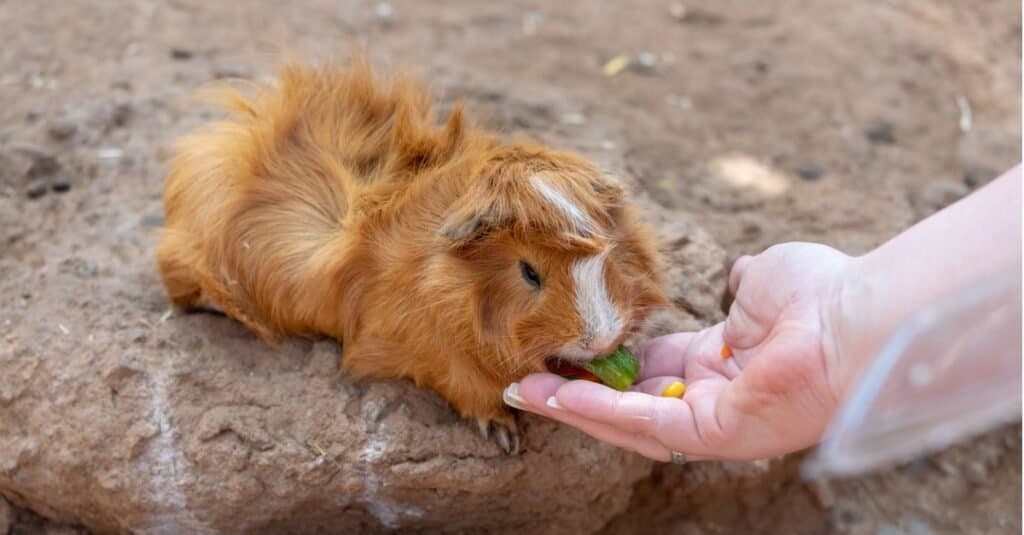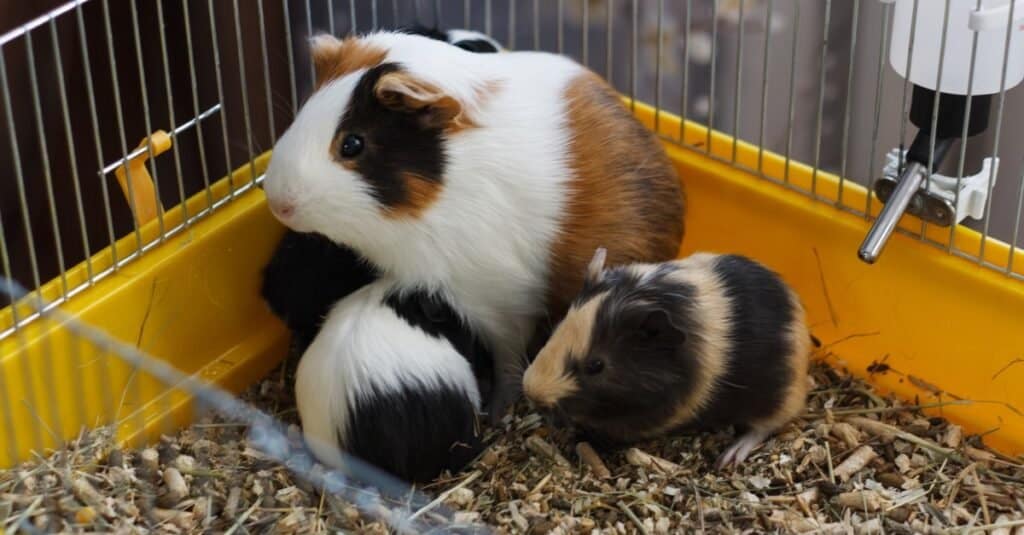Guinea pigs are adorable, sweet pets that love to express themselves by chattering, squealing, and wheeking. Some guinea pigs have swirls of long hair while others have a coat of soft, short hair. These little critters can be one solid color, two colors, or tri-colored! Many owners could spend hours watching these furry creatures jump, run, hide, and chomp on the hay in their cage. While some guinea pig owners have just one guinea pig, others have several they keep in separate cages. Of course, there’s another option to consider.
Some guinea pig owners take their pet adventure a step further by breeding their guinea pigs. Keeping a pregnant guinea pig means an owner takes on even more responsibility for their pet. Plus, they are adding several new ones to the collection! Naturally, someone who is new to guinea pig breeding has a lot of questions. One of the most basic questions: How long is a guinea pig pregnant? Getting an answer to this question means an owner can be ready for the new arrivals.
Keep reading to find out how long a guinea pig is pregnant, the signs she’s about to give birth, and what to do after the babies are born.
How Do I Know If My Guinea Pig is Pregnant?

©Lucie3/Shutterstock.com
With all of that fur, it can be difficult to determine whether a female guinea pig is pregnant. Fortunately, there are some specific signs to look for.
Weighing a female guinea pig once a week is one idea. If she starts out as a two-pound guinea pig and her weight slowly increases each week it can be a sign of pregnancy. A pregnant guinea pig can sometimes grow to twice her normal weight.
A kitchen vegetable scale with a bowl or dish on top of it is appropriate for weighing a guinea pig. This can be stainless steel or plastic. Be sure to keep your hand close to the guinea pig when she is on the scale to keep her from jumping out and injuring herself. Putting the scale on a low table or even on the floor can help to keep your pet safe during the weighing process.
A second way to tell whether a guinea pig is pregnant is to watch her eating habits. A pregnant guinea pig is going to eat more than usual to nourish the young developing inside of her. She may eat three times what she usually eats. Give her the normal amount of food, then observe how long it lasts.
Another option is to take the guinea pig to a small animal veterinarian. A vet can perform a physical examination to determine whether a guinea pig is going to have a litter of babies. He or she may even be able to give you an idea of the female’s due date. Furthermore, a veterinarian can offer tips on how to take the best care of this pet during pregnancy and afterward.
How Long Are Guinea Pigs Pregnant?
As with most animals, there’s not a set number of days that a guinea pig is pregnant. However, most guinea pigs have a pregnancy that lasts from 59 to 72 days. So, if you’re collecting items in preparation for the guinea pig babies, you may have only two months to get it all done!
How Do I Care for a Pregnant Guinea Pig?
Stress can prompt health issues for a pregnant guinea pig. So, one way to lessen a pregnant guinea pig’s stress is to put the cage in a quiet environment. If the cage is in a family room where the guinea pig is able to hear doors slam, the radio blaring, and the television on, move its cage to a bedroom that is quieter.
It’s important for a pregnant guinea pig to get enough rest. Putting the cage in a quiet room is going to help this pet get the proper amount of sleep. Also, in a room with less activity, the guinea pig won’t be disturbed by lights going on and off at all times of the day or night.
Make sure the pregnant guinea pig has plenty of vegetables mixed into its food. This is important even for guinea pigs that aren’t pregnant. The more vitamins and nutrients the female takes in, the healthier her babies will be.
Some ideas for vegetables to put into her bowl include:
- Green leaf lettuce
- Kale
- Romaine lettuce
- Parsley
As the due date approaches, avoid holding the female unless it’s necessary. The female’s body is changing a lot and she may feel vulnerable to injury as she’s being picked up and carried. Alternatively, talking to and petting the female can definitely help to keep her stress level under control.

©iStock.com/Vincent Scherer
Should I Remove Other Guinea Pigs from the Cage?
The answer to this question depends on the specific circumstances and attitude of the pregnant guinea pig. Knowing how important it is to keep a female guinea pig’s stress level down, it may be necessary to remove other guinea pigs from the cage or habitat.
As an example, a male guinea pig that is pushing against or bothering the female may be causing her stress. She may snap at him or chase him away. In this case, it’s best to remove the male and put him in a different cage. Try to avoid moving the female to a different cage so she can remain in familiar surroundings throughout her pregnancy.
It’s best to remove the female guinea pigs from the cage of a pregnant one. Female guinea pigs are likely to fight and that would definitely cause stress or even injury to the pregnant female.
Though the pregnant female is in her cage alone, it can be put near the cages of other guinea pigs. If she doesn’t become stressed by just seeing and hearing other guinea pigs, then it’s okay to have them in the same room.
How to Tell When a Guinea Pig is Ready to Give Birth?
Now that you know approximately how long a guinea pig is pregnant, you know when to start to look for signs that the guinea pig is close to giving birth. But what are the signs to look for?
A guinea pig that’s close to giving birth is likely to keep to herself. She may lie around in her cage and not respond to your words or efforts to play with it. The female is storing up her energy in preparation for giving birth to and nursing her young.
Nesting is something that many pregnant animals do in preparation for birth. As an example, a female dog moves blankets or bedding around in its dog house or bed before giving birth to puppies. But don’t expect a pregnant guinea pig to prepare a nest. Scientists aren’t sure why pregnant guinea pigs don’t prepare nests. Female guinea pigs feel comfortable giving birth in practically any area of a cage.
When this small animal goes into labor its body may make a hiccupping motion. This means the female is having contractions and the birthing process is moving forward. When this happens, it’s best to avoid touching the female. She is doing the serious work of giving birth and she may see your hand in the cage as a risk to her babies. A female has natural instincts and knows what to do. Isn’t that amazing?!

©DmitryPron/Shutterstock.com
What Should I Do After the Babies Are Born?
Most guinea pigs have three or four babies per litter. Of course, some of them have more. After the babies are born, the mother starts to nurse them. In terms of caring for the babies, the mother does all the work. But there are a few things you can do to help her along as a new mom.
Give your pet healthy food and fresh water every day. Eating nutritious food allows her to give her babies enough milk whenever they need it.
Wait at least two weeks before trying to hold any of the babies. It may be tempting to hold them right away, but their bodies are delicate. In short, they can be hurt very easily if handled too soon. Furthermore, a new mom is likely to become stressed out if you try to reach into the cage and take one of her babies.
You can clean the cage of a female and her new babies but do it carefully. Instead of giving it a full cleaning by removing all of the bedding, gently scoop out wet or soiled shavings and replace them with fresh ones. You’ll be able to give the cage a thorough cleaning after the babies are a few weeks old. But, when a female has newborns, it’s best to avoid disturbing her as much as possible.
It is worth noting that the new mother is quite capable of having another brood right after she has given birth.
What’s more, the adorable newborns soon become ready to become parents themselves pretty quickly.
Females reach sexual maturity after 28 days, and males take twice that amount of time. That makes it prudent to closely monitor the calendar and effect a swift separation as soon as possible.
Up Next…
Keep reading these posts for more incredible information about key animal facts.
- Guinea Pigs as a Pet: How to Care for Your Guinea Pig: They’re smart and affectionate and thrive under the very best care. Here’s how to make sure they get it.
- How Much Does a Guinea Pig Cost Per Year? Just how far will you have to dig into your coffers to keep your tiny furry friend, well watered, well fed and in excellent health? Find out here.
- Guinea Pig Types: The Ultimate Guide to Guinea Pig Breeds: Some have long silky coats, others are covered in curly fur. Some are gentler and easier going compared to others. Find out what breeds they belong to and what others exist in this comprehensive guide on guinea pigs.
The photo featured at the top of this post is © Naomi Marcin/Shutterstock.com
Thank you for reading! Have some feedback for us? Contact the AZ Animals editorial team.






